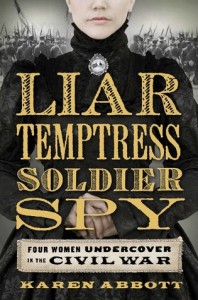 Format read: ebook provided by Edelweiss
Format read: ebook provided by EdelweissFormats available: ebook, hardcover, audiobook
Genre: history
Length: 533 pages
Publisher: Harper
Date Released: September 2, 2014
Purchasing Info: Author’s Website, Publisher’s Website, Goodreads, Amazon, Barnes & Noble, Kobo, Book Depository
Karen Abbott illuminates one of the most fascinating yet little known aspects of the Civil War: the stories of four courageous women—a socialite, a farmgirl, an abolitionist, and a widow—who were spies.
After shooting a Union soldier in her front hall with a pocket pistol, Belle Boyd became a courier and spy for the Confederate army, using her charms to seduce men on both sides. Emma Edmonds cut off her hair and assumed the identity of a man to enlist as a Union private, witnessing the bloodiest battles of the Civil War. The beautiful widow, Rose O’Neale Greenhow, engaged in affairs with powerful Northern politicians to gather intelligence for the Confederacy, and used her young daughter to send information to Southern generals. Elizabeth Van Lew, a wealthy Richmond abolitionist, hid behind her proper Southern manners as she orchestrated a far-reaching espionage ring, right under the noses of suspicious rebel detectives.
Using a wealth of primary source material and interviews with the spies’ descendants, Abbott seamlessly weaves the adventures of these four heroines throughout the tumultuous years of the war. With a cast of real-life characters including Walt Whitman, Nathaniel Hawthorne, General Stonewall Jackson, detective Allan Pinkerton, Abraham and Mary Todd Lincoln, and Emperor Napoleon III, Liar, Temptress, Soldier, Spy draws you into the war as these daring women lived it.
My Review:
“Tinker, tailor, soldier, sailor” is the first line of a nursery rhyme that continues with “Rich man, poor man, beggar man, thief.”
Ironically, both the corruption of the rhyme, “Tinker, tailor, soldier, spy” and “Rich man, poor man” have been turned into novels. Tinker, Tailor, Soldier, Spy being the well-known Cold War espionage thriller by John le Carré.
At the time of the U.S. Civil War, women weren’t supposed to be any of those things. But of course, women have often taken up occupations and professions that they were supposedly incapable or unqualified for.
So goes this historical account of four women who were not merely active, but in some cases famous (or infamous) for being spies, which necessitated them also being liars, temptresses and/or soldiers in order to fulfill their clandestine duties.
In this story, we see the Civil War through their eyes, and their documented records, instead of the usual historical accounts written by men. Two of these women operated for the Union, and two for the Confederacy. Everybody spied.
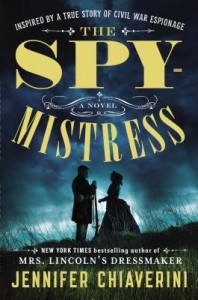 Elizabeth Van Lew was a Richmond abolitionist, but also a rich woman from a prominent family. She remained at her family home in Richmond throughout the War, spying assiduously for the Union. She often sent her dispatches north with escaped Union soldiers who she had helped free from the Richmond POW prisons. While her wartime services was recently fictionalized in The Spymistress (reviewed here) it is even more harrowing in this non-fictional version.
Elizabeth Van Lew was a Richmond abolitionist, but also a rich woman from a prominent family. She remained at her family home in Richmond throughout the War, spying assiduously for the Union. She often sent her dispatches north with escaped Union soldiers who she had helped free from the Richmond POW prisons. While her wartime services was recently fictionalized in The Spymistress (reviewed here) it is even more harrowing in this non-fictional version.
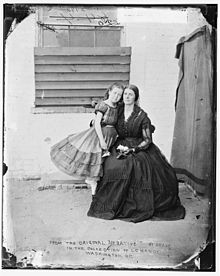 The picture of the war is also made much fuller by the account of Van Lew’s Confederate counterpart, Rose Greenhow. Greenhow was an ardent secessionist, but her family home was in Washington D.C. When the Union split, Rose saw her opportunity to use her knowledge of the insiders in Washington government to seduce and suborn as many high-ranking officials as possible, sending her dispatches south in the hands of young women and slaves. Her information was credited with helping the Confederacy win the first battle at Bull Run.
The picture of the war is also made much fuller by the account of Van Lew’s Confederate counterpart, Rose Greenhow. Greenhow was an ardent secessionist, but her family home was in Washington D.C. When the Union split, Rose saw her opportunity to use her knowledge of the insiders in Washington government to seduce and suborn as many high-ranking officials as possible, sending her dispatches south in the hands of young women and slaves. Her information was credited with helping the Confederacy win the first battle at Bull Run.
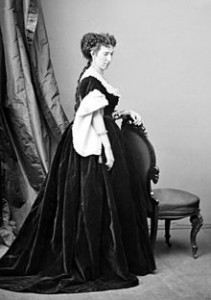 Belle Boyd is possibly the most infamous spy in the Civil War, to the point where Cherie Priest co-opted her identity for use in her Boneshaker series. But the real life Boyd was even more sensational than the fictional one. Boyd starts as a willful and completely uncooperative (and very young) woman in Martinsburg, Virginia. An ardent secessionist, she openly flirted and courted every Union officer who came within her orbit. Belle didn’t merely send dispatches, she also ran them herself. Martinsburg became part of the new state of West Virginia during the war, but she continued to spy on the Union.
Belle Boyd is possibly the most infamous spy in the Civil War, to the point where Cherie Priest co-opted her identity for use in her Boneshaker series. But the real life Boyd was even more sensational than the fictional one. Boyd starts as a willful and completely uncooperative (and very young) woman in Martinsburg, Virginia. An ardent secessionist, she openly flirted and courted every Union officer who came within her orbit. Belle didn’t merely send dispatches, she also ran them herself. Martinsburg became part of the new state of West Virginia during the war, but she continued to spy on the Union.
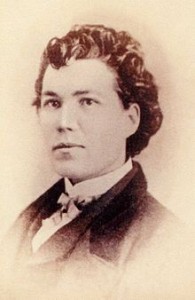 Last, but not least, Sarah Emma Edmonds serviced from 1861 until 1863 as Frank Thompson. Not, as the romantic literature often has it, because she was following a sweetheart, but simply as a way to escape her overbearing father. Because of her slight stature and small frame, she was frequently asked to spy on nearby Confederate regiments while dressed as a woman. It was a double disguise; a woman, pretending to be a man pretending to be a woman. It worked.
Last, but not least, Sarah Emma Edmonds serviced from 1861 until 1863 as Frank Thompson. Not, as the romantic literature often has it, because she was following a sweetheart, but simply as a way to escape her overbearing father. Because of her slight stature and small frame, she was frequently asked to spy on nearby Confederate regiments while dressed as a woman. It was a double disguise; a woman, pretending to be a man pretending to be a woman. It worked.
Their four stories interweave to form a fascinating narrative of the war. Emma tells the soldier’s story as she served at both battles of Bull Run, Antietam, Vicksburg and the Peninsula Campaign, some of the bloodiest battles of the war. Greenhow covers politics in Washington, and the Confederate campaign in Europe to achieve recognition. Both Boyd and Greenhow were imprisoned multiple times for treason to the Union, but their gender and their powerful friends protected them from execution.
Van Lew completes the picture; her insider’s guide to running a spy ring, and life in the Confederacy as the outlook changed from hope to despair.
In addition to their service, they all share surprisingly similar fates. The war turns out to have been each of their shining moments; their pinnacle of achievement. Greenhow did not survive, but the others all fell from places of high recognition to obscure deaths. Post-war life was not kind to any of them, whether they traded on their notoriety or tried to slip back into “normal” life.
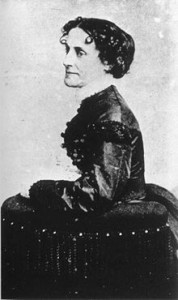 Reality Rating B+: I preferred this account of Van Lew’s life to the fictional one; while the outline was the same, this one felt like it contained less melodrama. In fiction, she came across as slightly wooden, but in a more factual account her achievements shone through.
Reality Rating B+: I preferred this account of Van Lew’s life to the fictional one; while the outline was the same, this one felt like it contained less melodrama. In fiction, she came across as slightly wooden, but in a more factual account her achievements shone through.
Although there is a popular image of female spies as femme fatales (i.e. Mata Hari) by showing four different women spies, we see the myriad possibilities that women had for espionage at a time when women’s roles were so prescribed. Boyd and Greenhow both acted the seductress; in fact, Boyd was referred to as the “Secesh Cleopatra” for her exploits. But Edmonds pretended to be a man, and was a successful soldier to the point that she was able to get her comrades in arms to testify sufficiently in her defense that she was awarded a military pension. Van Lew relied on her intelligence, and occasionally on family influence or downright smuggling, to get the information she needed. She acted the part of a Southern lady when required, but the emphasis would be on the “lady” part of that description.
Except for Greenhow, who died near the end of the war, the others all descended into obscurity. Both Boyd and Van Lew were considered crazy, to the point where Boyd ended in an asylum and Van Lew retreated into her house and her stories and seldom emerged.
While the use of the four women as points-of-view covered much of the action of the war on both the political and military fronts, it did occasionally jar as the perspective switched from one to another. Although the author’s technique of extrapolating what these women thought and felt made their narratives flow more smoothly, it did make me wonder whether the book veered a bit into fiction at those points. But it did make each of them come alive for the reader.

